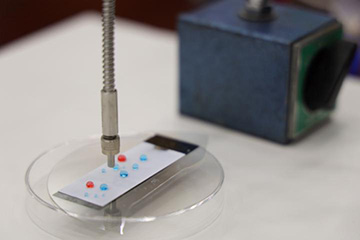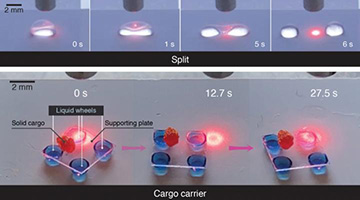
Demonstration of the light-controlled contamination-free fluidic processor. [Image: The University of Hong Kong]
Researchers in Hong Kong say they have developed a microfluidics platform that allows touch-free, precision control of droplets using a single beam of light (Sci. Adv., doi: 10.1126/sciadv.abc1693). Fluid placed on the new microfluidics device “beads up like a marble and readily rolls without residue,” says research team leader Liqiu “Rick” Wang, a chair professor of mechanical engineering at University of Hong Kong. “Once the laser light turns on, the fluid automatically follows the light spot.”
Testing toxic fluids
Many research, industrial and medical applications rely on the ability to precisely manipulate various chemical and biological fluids, Wang explains. But procedures like testing fluids that contain infectious virus or bacteria can be extremely high risk, sometimes fatal, he says.
“To test for Ebola, for example, medical staff must wear three layers of gloves and layers of protective garments,” Wang says. “A precise diagnosis often requires the medical staff to break sampled cells, filter and purify the virus’ genetic materials—a whole series of operations done in a fluidic medium.”
What is more, Wang says, fluids have no fixed shape, making them difficult to control on conventional microfluidics platforms. They can readily stick to solids, he adds, leaving residues that foul equipment and contribute to the global problem of plastics waste.
Eliminating plastics waste
For medical testing alone, Wang’s team reports, some US$20 billion worth of disposable plastics are consumed each year. Because of the residue problem, the resulting hazardous waste costs another US$10 billion to handle, the researchers say. In the pharmaceutical industry, machines used in drug discovery can consume up to one million plastic pipettes in a week, Wang says.
But the team did not set out to solve the plastics or other world problems. He says its goal was simply to create a microfluidic platform where light guides and controls droplet motions.
A laser-generated force field
To that end, the team devised a so-called superomniphobic three-layer surface that will repel water, oils and alcohols. Application of near-infrared (NIR) laser light—the research team’s magic wand, Wang says—generates a dielectrophoretic force to precisely control fluids atop the device surface nanostructures.
The superomniphobic platform is created by sandwiching thin pyroelectric crystal (lithium niobate wafer) between a silica nanosphere network and a photothermal thin film (graphene-doped polymer), the researchers write. As a NIR light beam irradiates from the top, the translucent surface and pyroelectric wafer become a transparent window, allowing the laser light to reach the underlying composite polymer film.
Through interfacial heat transfer, the authors continue, the pyroelectric crystal is heated and spontaneous polarization within the crystal is reduced, lowering bound surface charges, and giving rise to extra surface free charges. Droplets atop the surface, they say, are driven toward the irradiated spot by the resulting dielectrophoretic force
Biocompatible laser light
Top: The split of an ethanol droplet by a beam of light on the photopyroelectric microfluidic platform. Bottom: A light-controlled cargo carrier with droplet wheels transporting a solid cargo. [Image: The University of Hong Kong][Enlarge image]
“We chose near-infrared light as our trigger mainly because of its biocompatibility,” Wang says. At 780-nm wavelength, it is a value within the range for biological tissues—650–1350 nm. Light can efficiently penetrate biological tissues, while minimizing absorption and other side effects, he says.
“We have also confirmed that the thermogenesis of the underlying photothermal materials yields negligible change in the temperature of a controlled droplet,” Wang says. “In most cases, laser-generated heat would not alter the liquids being tested. If the droplet itself contains photothermal materials, such as graphene or Fe3O4 nanoparticles, however, the laser will directly heat the liquid up, potentially changing its properties.”
A wide spectrum of liquids
A wide spectrum of liquids, including silicone oils, alkanes and alcohols can be readily guided by an NIR light beam, the researchers write. The photopyroelectric platform and the wavy dielectrophoretic force field induced by the laser, they say, can trap and move droplets with a volume as low as 0.001 µl.
But a 200 µl liquid puddle can be effortlessly handled on the platform as well, Wang says. Such precision control, he adds, means droplets can be split or merged as desired, allowing applications in chemistry and the pharmaceutical industry. The authors even posit millimeter-scale cargo carriers to move solid particles on tiny droplet wheels driven by laser light.
The low-mass-loss advantage
But Wang says the most significant feature of their light-driven platform is low mass loss from the sample, which the study measured as insignificant and far better than technologies like Teflon coating that can be weathered by oil, dust or concentrated protein solutions.
Because of this low-mass-loss feature “We hope to have a fluidic processor that works with nearly all types of fluids and can be used for 1,000 or even 10,000 times without any washing or maintenance,” Wang says. Such efficiencies, he says, could speed diagnoses and lower costs.
As for commercial production, Wang says that the materials used for a single device cost only around US$50. “Compared with other techniques that require clean room and multi-step micro-or nano-fabrications, our devices can be fabricated using commonly-available facilities such as a spin coater and furnace,” explains Wang. Although, he points out, the superominphobic surface is somewhat time-consuming to produce, making it “the biggest challenge for high-throughput manufacturing.”
Optics- and AI-integrated platforms
With further development, Wang says, the team plans to integrate the platform with a geometric-optics and artificial-intelligence system.
“In our study, we move the triggering laser by fixing it on an XY translation platform. With an optical system, the position of the laser spot can be controlled without moving parts, making the system more compact,” he says. “By combining with an AI system, we can make the precision manipulation of liquids automatic without human surveillance—a feature that is highly desirable in industries such as drug discovery.”

